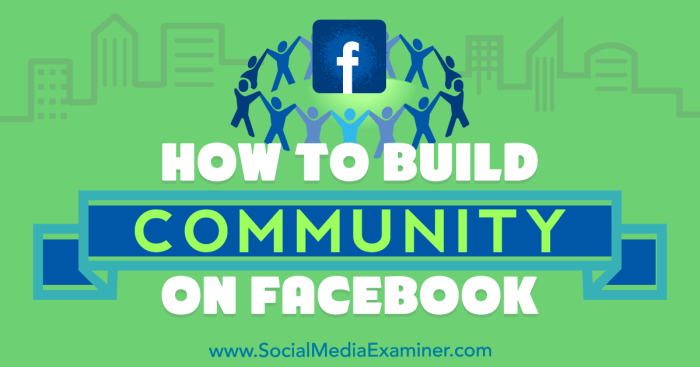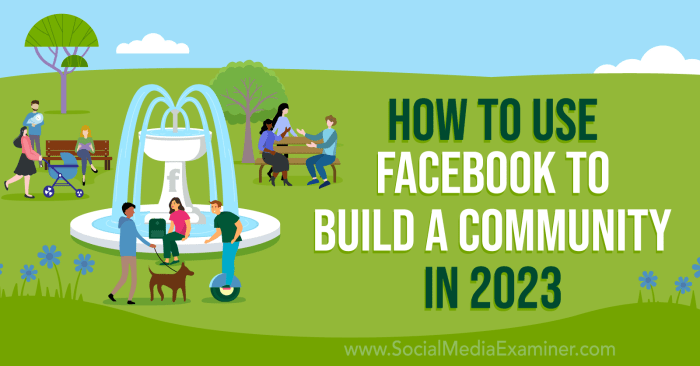Building a Community on Facebook kicks off the social media game strong, diving into the importance, strategies, engaging content ideas, and management tips for creating a thriving online community. Get ready to boost your brand presence and foster meaningful connections!
Importance of Building a Community on Facebook
Building a community on Facebook is crucial for businesses and organizations in today’s digital age. With over 2.8 billion active users, Facebook offers a vast platform to connect with potential customers, build relationships, and increase brand visibility.
A strong community on Facebook can enhance brand loyalty by fostering a sense of belonging and connection among followers. By engaging with customers through meaningful interactions, businesses can build trust and loyalty, leading to repeat purchases and positive word-of-mouth referrals.
Enhancing Brand Loyalty and Customer Engagement
- Creating a community where customers can share their experiences, ask questions, and provide feedback helps businesses show they value their customers’ opinions.
- Regularly posting relevant and engaging content, such as behind-the-scenes looks, product updates, and exclusive offers, can keep followers interested and invested in the brand.
- Responding promptly to customer inquiries and concerns shows a commitment to excellent customer service, further strengthening brand loyalty.
Examples of Successful Facebook Communities
- The “Humans of New York” Facebook page, known for sharing compelling stories and photos of individuals in New York City, has amassed over 18 million followers. This community engagement has led to increased awareness and support for various charitable causes featured on the page.
- Lululemon, a popular athletic apparel brand, has built a dedicated community on Facebook through their “Sweat Collective” group. This group offers exclusive perks and events for members, fostering a sense of belonging and loyalty among customers.
Strategies for Building a Community on Facebook

Building a strong and engaged community on Facebook requires a strategic approach that involves creating engaging content, hosting events, and leveraging user-generated content. Consistency in posting and engaging with community members is also crucial to maintaining an active and vibrant community. Here are some key strategies to consider:
Create Engaging Content
- Post a variety of content, including images, videos, polls, and questions to keep your audience interested and entertained.
- Encourage discussions by asking for feedback, opinions, and stories from community members.
- Respond to comments and messages promptly to show that you value and appreciate your community’s engagement.
Host Events
- Organize virtual or in-person events such as webinars, live Q&A sessions, contests, or meetups to bring community members together.
- Promote events on your Facebook page and other social media platforms to attract a larger audience and increase engagement.
- Create a sense of exclusivity by offering special perks or discounts to event attendees.
Leverage User-Generated Content, Building a Community on Facebook
- Encourage community members to share their own content, such as testimonials, reviews, and user-generated videos, to showcase their experiences and build trust among the community.
- Feature user-generated content on your Facebook page to highlight community members and show appreciation for their contributions.
- Create interactive campaigns or challenges that encourage users to create and share content related to your brand or community.
Consistency in Posting and Engagement
- Establish a regular posting schedule to keep your audience informed and engaged.
- Monitor and respond to comments, messages, and mentions to show that you are actively listening and engaging with your community.
- Use analytics to track the performance of your posts and engagements to optimize your content strategy and improve community interaction.
Encourage Interaction and Foster Belonging
- Create polls, quizzes, and interactive posts to encourage community members to participate and share their thoughts.
- Recognize and appreciate active community members by featuring their contributions or giving them shoutouts on your page.
- Create a welcoming and inclusive environment where all members feel valued, respected, and part of a larger community.
Engaging Content Ideas for Facebook Community
Creating engaging content is crucial for building a vibrant and active Facebook community. Here are some ideas to drive engagement:
Polls
- Use polls to gather feedback from community members on various topics.
- Ask fun and relevant questions to encourage participation.
- Share the results with the community to keep them engaged.
Contests
- Organize contests with exciting prizes to incentivize participation.
- Encourage user-generated content like photos or videos related to the community.
- Acknowledge and celebrate the winners to foster a sense of community spirit.
Live Videos
- Host live Q&A sessions, tutorials, or behind-the-scenes looks to connect with members in real-time.
- Engage with viewers by responding to comments and addressing their queries.
- Announce upcoming live sessions to build anticipation and attract more viewers.
Behind-the-Scenes Posts
- Offer a glimpse into the inner workings of your community or organization.
- Share stories, photos, or videos that showcase the people behind the scenes.
- Humanize your brand and create a sense of transparency and authenticity.
Significance of Storytelling in Creating Meaningful Connections

Storytelling is a powerful tool for building emotional connections with community members. By sharing compelling stories, you can:
- Create a sense of empathy and understanding among community members.
- Inspire and motivate individuals by highlighting real-life experiences and challenges.
- Establish a unique identity for your community and differentiate it from others.
Tips on Tailoring Content to Resonate with the Target Audience
To ensure your content resonates with your target audience, consider the following tips:
- Understand the interests, preferences, and demographics of your audience.
- Create content that addresses their needs, challenges, and aspirations.
- Use language and visuals that are relatable and appealing to your audience.
- Solicit feedback and suggestions from community members to tailor content accordingly.
Managing and Moderating a Facebook Community
Setting clear community guidelines and moderating discussions are crucial for maintaining a positive environment within a Facebook community. It helps in fostering a safe space for members to engage, share ideas, and connect with one another. Consistent moderation also ensures that the community remains aligned with its purpose and values.
Importance of Clear Community Guidelines
- Establishing clear rules: Clearly defined guidelines help members understand what behavior is acceptable and what is not within the community.
- Promoting respect: Guidelines can encourage respectful interactions and discourage toxic behavior such as hate speech, bullying, or harassment.
- Creating a sense of belonging: When members know what is expected of them, they are more likely to feel like they belong to the community and actively participate.
- Protecting the community: Guidelines serve as a way to protect the community from spam, inappropriate content, or malicious activities.
Handling Conflicts and Negative Interactions
- Addressing conflicts promptly: Act quickly to resolve conflicts between members to prevent escalation and maintain a harmonious environment.
- Encouraging constructive dialogue: Guide discussions in a positive direction by encouraging constructive criticism and open communication.
- Dealing with negative interactions: Remove inappropriate content, warn or ban repeat offenders, and take necessary actions to uphold community standards.
- Seeking feedback: Regularly solicit feedback from members to understand their concerns and improve community dynamics.
Engaging with Members and Resolving Issues
- Active engagement: Interact with members by responding to comments, asking questions, and acknowledging their contributions to foster a sense of community.
- Addressing feedback: Listen to feedback from members, take their suggestions into account, and implement changes that enhance the community experience.
- Resolving issues effectively: Approach problems with a solution-oriented mindset, communicate transparently with members, and take decisive action when needed.
- Building trust: By consistently engaging with members, addressing feedback, and resolving issues, trust and loyalty within the community can be fostered.





